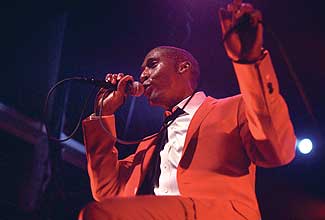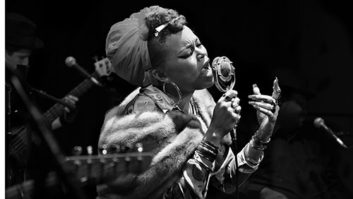
Raphael Saadiq’s vocal warmth is heard through a Shure SM58.
Raphael Saadiq has covered a lot of ground in the music business. Following his days as the lead vocalist for the multi-Platinum R&B group Tony! Toni! Tone! in the late ’80s and ’90s, he went on to form Lucy Pearl with members of En Vogue and A Tribe Called Quest, and to write and produce for major artists including D’Angelo, Mary J. Blige and Earth, Wind & Fire. In the past decade, Saadiq has also gone solo, releasing two albums that garnered critical acclaim and eight Grammy nominations between them. While he has often fused the many genres he heard growing up in Oakland, Calif. — from hip-hop and rock to funk and soul — his latest release, The Way I See It (profiled in Mix‘s Jan. ’09 issue), is a focused homage to the classic sounds of early Motown.
“I’m not saying the Motown sound is me, but I was raised on a Fender Stratocaster and a Les Paul,” Saadiq says at his recent touring stop in New York City’s Terminal 5. “They’ve been in my house consistently since I was born. I grew up playing Fender guitar and bass — they’ve been like a piece of furniture in the house, all the time, and I knew exactly what they were used for.”
Today, Saadiq takes this love for vintage gear and priceless instruments to create a mesmerizing live performance, complete with a six-piece band dressed in matching suits and ties — except for vocalist Erika Jerry, who is resplendent in a classy period dress. His act evokes Motown’s heyday visually and musically, right down to the horn hits and synchronized dance moves. However, his eclectic side also comes through when he plays his more hip-hop- and rock-influenced songs from earlier albums.
To help translate Saadiq’s sound to a live setting, his engineers do everything they can to warm things up. Front-of-house engineer Kenyatta Kelo Saunders (a Grammy-winning engineer/producer) uses a Native Instruments Guitar Rig to help get a vintage sound, as well as Apogee’s Symphony Mobile. And while the tour doesn’t carry any other gear, their tech rider requests all-tube amps for the band’s backline: Ampeg Classic SVT for the bass with an 810 tube amp and Fender Twins for guitars.

Monitor engineer Jon Lammi and FOH engineer Kenyatta Kelo Saunders at Terminal 5’s Yamaha PM5D desk
Photos: Paule Saviano
“We’ve been adjusting the stage setup a little bit,” says monitor engineer Jon Lammi, formerly with Aerosmith and Blue Man Group. “Rob Bacon, our lead guitar player, has been sometimes using a single Fender Twin, sometimes two Twins in stereo. And Raphael has been using a single Twin. For some reason tonight, we couldn’t get Twins so we have four Fender Deluxes, re-issues. They’re circuit-board-printed, not point-to-point, and they’re not vintage at all, but they’re modeled after [the old Fender Deluxes].”
Sorting Through a Club’s Racks
For their show in New York, the engineers are mixing on the venue’s Yamaha PM5D desks. Saunders — who has mixed live for Jay-Z, The Roots and Joss Stone — generally doesn’t prefer digital consoles. “I’m a Midas dude,” he says. “Give me some analog warmth, especially for this band — it deserves to have vintage gear. A couple of tours ago, I carried a rack that had a whole bunch of stuff in it. But with us flying and doing all this different stuff, the rack was just too expensive to carry. I think we’d rather have horns versus the rack, you know?”
Although they carry no outboard gear, Saunders does like to throw some effects into the mix. “I play with delays a lot,” he says. “I lucked out and got a TC Electronic D2 delay today from Marciano [Saadiq’s manager], so at least I can tap the delay out. I put them on the vocals to carry whatever [Saadiq] is saying, to add more drama. I put them on the guitar at points too, sometimes even the toms.
“I’m a really aggressive mixer,” he continues. “The drums are going to be in your face, the bass is definitely going to move you. Everything jumps out of the speakers — especially with this band because they’re just so awesome! When they hit, you want to feel it — bap bap!”
Lammi adds, “[The band] reacts, too; they can hear the P.A. when it’s slapping back from the room.” “They play into it,” Saunders confirms.
That said, he thinks the sound system is great for this particular venue. “If it was a bad system, we’d have to augment it with something, anything — I don’t care what it is. Is it old? Is it warm? Put it everywhere.”
The size of the venues has increased during the course of the tour, moving up from clubs to theaters, with Terminal 5’s capacity around 2,000. Because the venues vary from night to night, Lammi notes that the Recall feature on a digital board wouldn’t help, even if they carried one. “For me, even if I have the [memory] card, I’ll just dial it up from scratch. The club asked me if I had a card today, but since it’s a different room…” Saunders finishes for him: “There’s no continuity so you can’t rely on what you had in another room.”
“The trick is to make it sound consistent, no matter what we’ve had,” Lammi says. Sometimes this means that he has to sort through a pile of wedge monitors in the club (the band does not use in-ears) and determine what’s working and what isn’t, occasionally fixing an amp just so the show can go on. Lately though, their luck has been good, and Lammi says they’ve played in a lot of decent rooms with good systems.
Working With the Band
Terminal 5 uses Clair Global systems for both monitor and main loudspeaker systems. There are 10 to 20 i2121 line array speakers per side, with eight CS218 floor sub-low speakers, and 2-1 S218 cluster sub-low speakers per side. Both systems have Lab.gruppen amplifiers and Dolby Lake Processors (LP4D12s on the main speaker system and LP4D8s on the monitors). With this system, Lammi can mix without a lot of EQ’ing onstage. Plus, “the band isn’t that loud, so that helps,” he adds. “They’re great, very professional. And nobody is trying to take over onstage at all, so it’s just a matter of balancing them.”
“The processors fine-tune everything and add a lot of warmth,” Saunders says. “Whatever Jon does will play into the house, and vice versa. It’s kind of a game that he and I play back and forth to keep the balance.”
The band comprises two backing vocalists, Erika Jerry and B.J. Kemp; drummer Lemar Carter; keyboardist Charles Jones, playing two Yamaha Motifs and a Nord Electro for organ sounds (“Sometimes we get lucky and we get a Leslie and a B3,” Saunders says); saxophonist Scott Mayo; trumpeter Jamelle Williams; bassist Calvin Turner; and guitarist Bacon. Saadiq plays an additional guitar.
All of the singers use Shure SM58s, the only microphones that the tour carries (for hygienic reasons). Saunders uses a longer plate reverb on the vocals, with an occasional hall reverb. “We really like plates because they are kind of old-school, like Raphael,” he says. “When he recorded the album, he used a real plate and everything was original, so it was really true to that style of music — Motown and Stax.” Lammi also uses a plate reverb on Saadiq’s vocals in the monitors so the vocalists can get the effect in their mixes. “I’ll take a plate reverb in the console and I’ll take off all the highs in the wedges, a bit of the lows and give him this bed to play with so it doesn’t sound too sterile onstage,” he says.
The trumpet and sax are miked with Sennheiser 421s. “We had two other horn players [from P-Funk] and they preferred an SM58. They were very old school; actually, one was Parliament’s horn player,” Saunders says. “So they were just masters at working the 58. But some people can’t maneuver around it in the same way, so we’re using 421s now. They’re adding a little deeper dimension to the horns. We want it to sound dark, and they’re a little bit brighter, but we can shape it enough to be darker.”
For the kick drum, Saunders mikes the inside with an SM91 or a Shure Beta, and the outside with an Audix D6, which he calls “my all-time favorite kit mic. It automatically dumps out or rejects the trash you don’t want, and it has a tremendous bottom end and a little click to it.” The snare top and bottom take SM57s and Saunders adds a short plate reverb to that sound. Sennheiser e 604s or Audix D2s are on toms, while overheads see AKG 414s. Saunders notes, however, that things change from night to night depending on the club’s microphone package.
The tour ended shortly after the Terminal 5 show, and Saadiq headed back into the studio to record his next album. Of his touring band, Saadiq says, “I’m just very fortunate to have a group of musicians who listen to my album, and everybody tries to make the sounds live like it sounds on the record. I think it’s very important that we play with that spirit and energy; I think that’s what carries into the music. There’s a technical thing, but there’s a mental/technical aspect that makes it all coincide and work together.”
Gaby Alter is a New York City-based writer.





